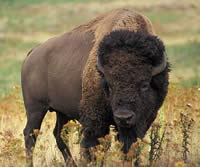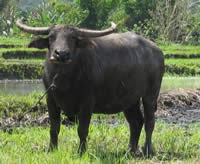Difference between Bison and Water Buffalo
Key Difference: Bison and Water buffalo are two different types of bovidic animals. However, they differ in looks, size, weight, behavior, diet and many other factors.
Bison and water buffalos are often confused as they are similar in looks and even have a similar taxonomy. Both the bison and water buffalo belong to kingdom (Animalia), class (Mammalia), order (Artiodactyla), family (Bovidae), but differ in genus and species. These two animals are different from each other in many ways.
Bison can be divided into two subspecies depending on their location: The American Bison and The European Bison. The European bison is also known as wood bison or wisent, while the American bison is often called American Buffalo, though it should not be mistaken with a buffalos.
 The European bison were almost hunted to extinction during 1919-1927 but since then have been reintroduced to the wild from captivity. They were often hunted during the Middle Ages for their hide and horns. They are now marked as Vulnerable by the IUCN. The European bison are large stocky creatures and can range between 7 and 10 ft in length and are between 5 and 7 ft tall. The tail ranges between 30 and 60 cm (12 and 24 in) in length. They also weight from 300 to 920 kg (660 to 2,000 lb), while some can even go up 2,200 lbs in captivity. European bison are herbivores and can be found mostly in large meadows or near water resources as water plays a huge part in their diet. The European bison are native to many parts of Europe including Russia, Ukraine, Poland, Germany, Belarus, etc. The Wisents are herd animals and can reside in mixed herds as well as bachelor herds. Reproduction is usually done by adult males, and gestation period lasts around 264 days; the female births only one offspring at one time. Wisents are not territorial and can share their land with multiple herds. The lifespan of a wisent can range between 13-21 in the wild and up to 30 years in captivity.
The European bison were almost hunted to extinction during 1919-1927 but since then have been reintroduced to the wild from captivity. They were often hunted during the Middle Ages for their hide and horns. They are now marked as Vulnerable by the IUCN. The European bison are large stocky creatures and can range between 7 and 10 ft in length and are between 5 and 7 ft tall. The tail ranges between 30 and 60 cm (12 and 24 in) in length. They also weight from 300 to 920 kg (660 to 2,000 lb), while some can even go up 2,200 lbs in captivity. European bison are herbivores and can be found mostly in large meadows or near water resources as water plays a huge part in their diet. The European bison are native to many parts of Europe including Russia, Ukraine, Poland, Germany, Belarus, etc. The Wisents are herd animals and can reside in mixed herds as well as bachelor herds. Reproduction is usually done by adult males, and gestation period lasts around 264 days; the female births only one offspring at one time. Wisents are not territorial and can share their land with multiple herds. The lifespan of a wisent can range between 13-21 in the wild and up to 30 years in captivity.
The American bison is a species of bison that are native to North and South America and were nearly extinct due to commercial hunting and slaughter in the 19th century and due to the spread of the bovine disease. Due to reserves and national parks, they have been resurged and are now marked as Near Threatened by the IUCN. The American bison can be further classified into two subspecies: the plains bison (Bison bison bison) and the wood bison (Bison bison athabascae). The wood bison is bigger than the plains bison and has a taller squarer hump, while the plains bison has a smaller rounder hump. The bison has a thicker, shaggier winter coat and a lighter color and lighter weight summer coat. The American bison’s head and body length ranges from 6.6 to 11.5 ft long and shoulder height of 60 to 73 in. The tail is between 12 and 36 in long. The male bison are generally bigger compared to female bison. The bison can weight from 318 to 1,000 kg (700 to 2,200 lb). Bison are herbivore and feed on grasses and sedges and can be found on near pastures, prairies and plains. They also consume a lot of water and snow as a part of their diet. American bison are raised for their meat and their hide, though they have not been able to be domesticated yet. The American bison are migratory animals and their herd migrations can be directional as well as altitudinal. Female and male bison reside in separate herd that only mix during breeding season. The male bison play no part in the raising of the young, and the female birth one offspring at one time. The lifespan of an American bison is 13-25 years.
Compared to the American bison, the European bison are slightly lighter in body mass and have taller. The Wisent also sport shorter hair on the neck, head, and forequarters, but have longer tails and horns. Both the species have a curved horn, however the European bison’s horns point forward through the plane of their faces, making it easier for them to interlock horns. The European bison has 14 ribs, while the American bison has 15. The European has five lumbar vertebrae, while the American has four. American bison tend to graze more and browse less than the European bison, due to the European bison’s neck being set differently.
Water buffalo can also be divided into two different types: Domestic Water Buffalo and The Wild Water Buffalo. The domestic water buffalo is also known as domestic Asian water buffalo, while the wild water buffalo is also known as Asian buffalo and Asiatic buffalo.
 Water buffalos are domesticated Bovidae animals that are often native to Asia, Australia, Europe, Middle East, North America and South America. These animals contribute the most to our meat and dairy habits. They are breed for this particular purpose, as well as used for farming and as pack animals. Due to the massive number of breeding, these are found in abundance in many places and countries are also known as common buffalos. Water buffalo are usually around 9.8 feet long and 6.6 feet tall in size. They are descended from the wild water buffalo. Buffalos spend most of their time grazing and being submerged in water and also are found in areas that are near water resources such as streams, wetlands, forests, marshes and swamps. They can range in various colors such as black, white and brown and have curved and swept-back horns. Water buffalos require proper nutrition for reproduction and usually reproduce every alternate year. Female buffalos can only produce one offspring at one time. Water buffalos prefer to feed on grass and forbs, but also survive on leaves and certain shrubs. The lifespan of water buffalos are 25 -30 years in captivity.
Water buffalos are domesticated Bovidae animals that are often native to Asia, Australia, Europe, Middle East, North America and South America. These animals contribute the most to our meat and dairy habits. They are breed for this particular purpose, as well as used for farming and as pack animals. Due to the massive number of breeding, these are found in abundance in many places and countries are also known as common buffalos. Water buffalo are usually around 9.8 feet long and 6.6 feet tall in size. They are descended from the wild water buffalo. Buffalos spend most of their time grazing and being submerged in water and also are found in areas that are near water resources such as streams, wetlands, forests, marshes and swamps. They can range in various colors such as black, white and brown and have curved and swept-back horns. Water buffalos require proper nutrition for reproduction and usually reproduce every alternate year. Female buffalos can only produce one offspring at one time. Water buffalos prefer to feed on grass and forbs, but also survive on leaves and certain shrubs. The lifespan of water buffalos are 25 -30 years in captivity.
Wild water buffalos are closely related to the water buffalos and are their ancestor. Wild water buffalos, true to their name are not domesticated and are wild animals. Due to hunting, the numbers of this animal have dwindled and they are now considered as endangered species by the IUCN. They are the second-largest wild bovid, with the gaur being the only bovid passing it. Wild water buffalos have a head-to-body-length of 94 to 120 in, a shoulder height of 59 to 75 in. Their tails range between 60 and100 cm (24 and 39 in) in length. They can weigh from 700 to 1,200 kg (1,500 to 2,600 lb). Similar to their domesticated cousins, this species also loves residing in moist places that are close to water resources such as wet grasslands, swamps and densely vegetated river valleys. Wild water buffalos are both diurnal (active during the day) and nocturnal. Both the male and female wild water buffalos form separate clans and interact during the mating season. Wild water buffalos are known for their short temper and will attack if they are provoked. Breeding season for wild water buffalos is usually in October and November with gestation period of 10 to 11 months. However, some species mate year round. Wild water buffalos’ diet consist of true grasses such as scutch grass, and sedges, as well as herbs, fruits, bark, trees and shrubs. They can also feed on rice, sugarcane, and jute. The lifespan of wild water buffalos is around 25 years in the wild. These species continue facing various threats such as interbreeding with domestic buffalos, hunting, habitat loss, degradation, diseases and competition.
|
|
Bison |
Water Buffalo |
|
Other names |
American buffalo; European wood bison or wisent. |
Domestic Asian water buffalo; Asian buffalo and Asiatic buffalo. |
|
Kingdom |
Animalia |
Animalia |
|
Class |
Mammalia |
Mammalia |
|
Order |
Artiodactyla |
Artiodactyla |
|
Family |
Bovidae |
Bovidae |
|
Genus |
Bison |
Bubalus |
|
Species |
B. bonasus (European); B. bison (American) |
B. bubalis (Water Buffalo); B. arnee (Wild Water Buffalo). |
|
Conservation status |
Vulnerable (European); Near Threatened (American). |
Least Concern (Water Buffalo); Endangered (Wild Water Buffalo). |
|
Size |
European bison can range between 7 and 10 feet in length and is between 5 and 7 feet tall. The tail ranges between 30 and 60 cm (12 and 24 in) in length. The American bison’s head and body length ranges from 6.6 to 11.5 feet long and shoulder height of 60 to 73 in. The tail is between 12 and 36 in long. |
Water buffalo are usually around 9.8 feet long and 6.6 feet tall in size. Wild water buffalos have a head-to-body-length of 94 to 120 in, a shoulder height of 59 to 75 in. Their tails range between 60 and100 cm (24 and 39 in) in length. |
|
Weight |
European bison can weigh from 300 to 920 kg (660 to 2,000 lb), while American bison can weight from 318 to 1,000 kg (700 to 2,200 lb). |
Water buffalo can weigh from 400 kg to 1,200 kg (880lb -2,600 lb). Wild water buffalo can weigh from 700 to 1,200 kg (1,500 to 2,600 lb). |
|
Body type |
Four footed, huge structure, large hump. |
Both genuses are four footed, huge frame, no hump. |
|
Habitat |
European bison are found in meadows and near water resources. American bison are found near pastures, prairies, and montane and northern areas. |
Water buffalos are found near streams, wetlands, forests, marshes and swamps. Wild water buffalos are found in wet grasslands, swamps and densely vegetated river valleys. |
|
Behavior |
European bison reside in mixed herds and are not family units. They mix with other herds and often change individuals. They do not defend their territory and often share with other herds. American male and female herds are usually separate. They have a dominant bison in their heard, usually a bison that was born during the early mating season. |
Water buffalos spend most of their time submerged in water. Also in order to be used as pack animals, the herder must walk either beside them or in front of them. Wild water buffalos are both diurnal and nocturnal. Adult females and their offspring from medium to large clans. Adult males form bachelor groups and only interact with females during mating season. |
|
Reproduction |
European bison resides in mixed herds and are not family units. Mating occurs from August through to October and the female only births one offspring at one time. American male and female herds are usually separate and do not mix until breeding season. Mating occurs in the first 2-3 weeks of the season. The females give birth to offspring at one time. |
Water buffalos require proper nutrition for reproduction and usually reproduce every alternate year. The young stay with the mother for three years before joining a small all-male herd. Wild water buffalos live in herds and the dominant male buffalos mate with females of the clan. Breeding season is usually in October and November with gestation period of 10 to 11 months. Some species mate year round. |
|
Native to |
American bison is native to North and South America, while European bison various parts of Europe, including Poland, Russia, etc. |
Water buffalos are native to Asia, Australia, Europe, Middle East, North America and South America. Wild water buffalos are native to India, Nepal, Bhutan, Thailand, Cambodia and Myanmar. |
|
Diet |
European bison feed on grasses, shoots and leaves. American bison feed on grasses and sedges, while consuming large amounts of water or snow. |
Water buffalos prefer to feed on grass and forbs, but also survive on leaves and certain shrubs. Wild water buffalos feed on true grasses such as scutch grass, and sedges, but also eat herbs, fruits, bark, trees and shrubs. They can also feed on rice, sugarcane, and jute. |
|
Fur |
Thick fur that changes color depending on weather. |
Water buffalos can also have a light fur. No fur, however wild water buffalos have small coarse hair from the haunches to the long and narrow head. |
|
Beard |
Yes |
No |
|
Horns |
European bison and American bison both have short, curved horns. However, European bison’s horns point forward through the plane of their faces, making it easier for them to interlock horns. |
Water buffalos have curled horns that are swept-back. Both of the sexes in wild water buffalos have horns that are heavy at the base and extend up to 79 in and become pointed at the end. |
|
Domesticated |
No |
Yes (water buffalo); No (wild water buffalo) |
|
Lifespan |
13-21 years |
25-30 years (water buffalo) 25 years in the wild (wild water buffalo) |
|
Predators |
Wolf and bears (European) Humans and diseases (American). |
Humans and crocodiles (water buffalo). Tigers and bears (wild water buffalo). |
|
Uses |
Meat, clothing, shelter and weapons. In the past, horns were hunted for producing drinking horns. |
Water buffalos are used as draft, meat, and dairy animals. Their dung is used as a fertilizer and fuel. Some are also used as pack animals. Wild water buffalos are used to manage uncontrollable vegetation growth in some places, along with opening up clogged bodies of water. |
Image Courtesy: fanpop.com, travel-junkie.com









Add new comment